Bordeaux Old Town is spread out on a curve along the western side of the River Garonne. This part of town has been listed as World Heritage by UNESCO since 2007 under the name Port de la Lune (Port of the Moon). This name was given in reference to the curve of the Garonne that takes the shape of a crescent at Bordeaux (the crescent is also found in the city’s coat of arms).
General Overview of Bordeaux Old Town
The heart of Bordeaux is made up of narrow streets as well as grand boulevards lined with stately mansions, neo-classical squares, popular museums and a frequented shopping district. The city went under a radical transformation in the 18th century and many monuments that have become iconic to the city today were built in neo-classical style.
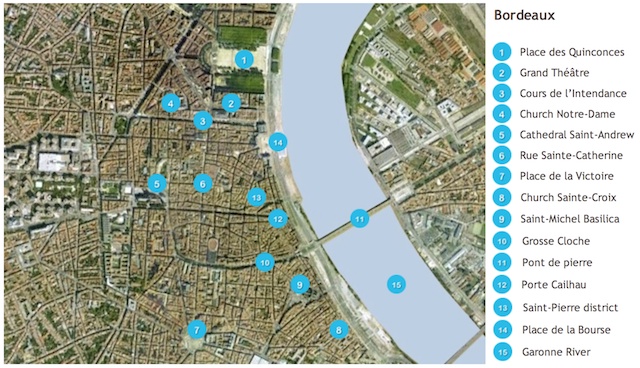
Bordeaux now has more than 5,000 houses from the 18th century, most of which have been successfully restored to their original splendour, thanks to a large-scale restoration programme in the 1980s and 1990s. Bordeaux is the French city that accounts for the highest number of listed historic monuments, 350 buildings, just after Paris.
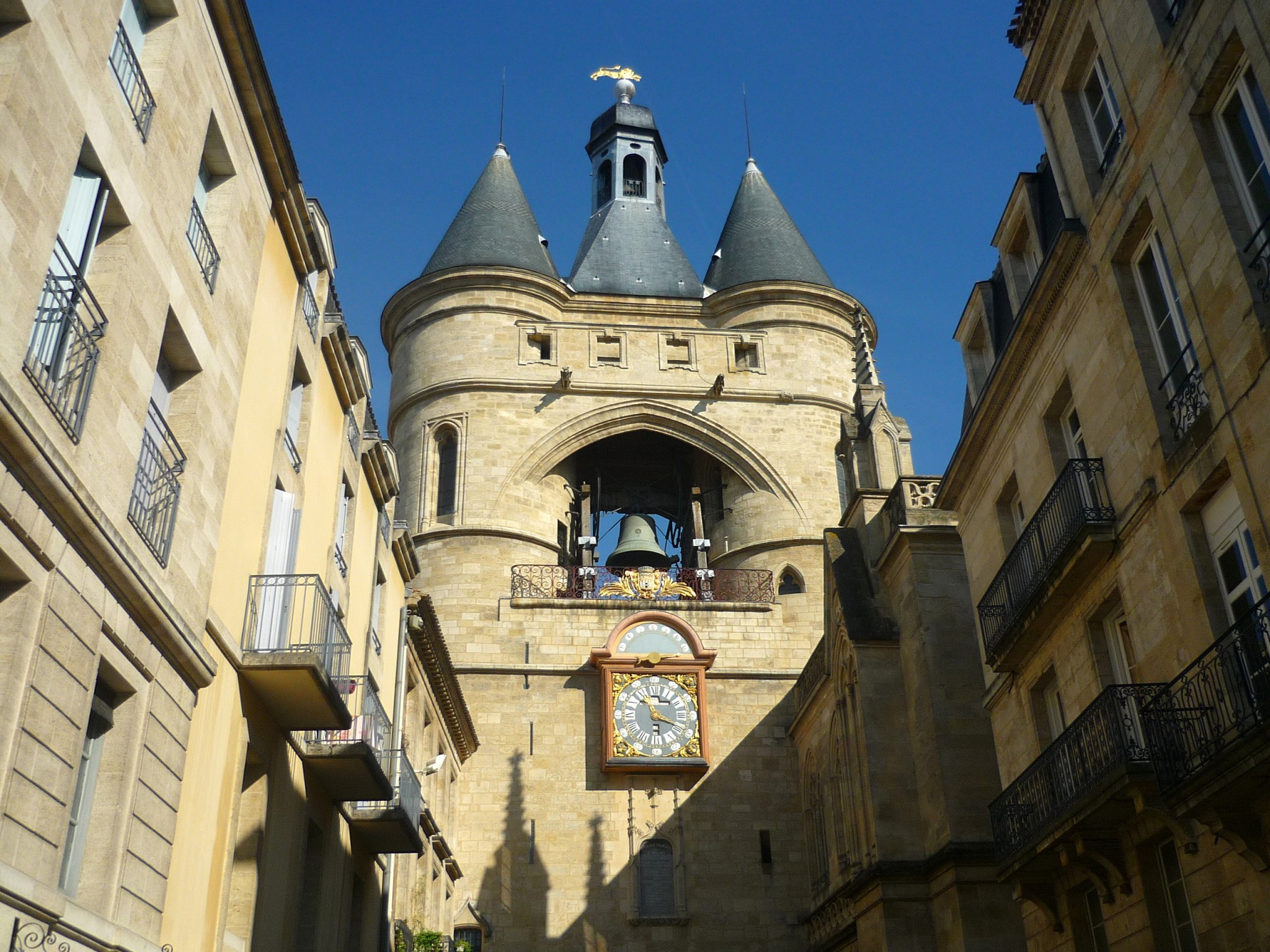
Below, you will find our tourist guide to Bordeaux’s old town, following a loop itinerary starting from the monumental square of Place des Quinconces to Place de la Bourse, via some of Bordeaux’ most famous monuments and districts.
1. Place des Quinconces
Place des Quinconces is the main square of Bordeaux’s city-centre. It was created on the site of the Château Trompette, which was dismantled in 1816 when it became the property of the city of Bordeaux.

The main esplanade is framed by trees and statues of Montesquieu and Montaigne on its north and south sides; by the Girondists’ Monument (also called Monument aux Girondins) on its west side; and by the two Rostral Columns and the river (la Garonne) on its east side. The name of the square comes from the trees that were planted in quincunxes. With an area covering 12 hectares, the Place des Quinconces is the largest square in France and one of the largest in Europe, which allows it to host events such as concerts and fairs. The Pleasures’ Fair, a funfair, and the Autumn Fair, a flea market, attract thousands of participants each year.
The Rostral Columns, built in 1829, symbolises trade and shipping, which used to be Bordeaux’s two lungs. The Colonne des Girondins was built from 1894 to 1902 to commemorate the Girondist deputies, whose last members were executed in this square in 1794, during the Reign of Terror of the French Revolution. The Column project was merged with a fountain project that was already commissioned, that is why the Column was built between two fountains that represent in bronze the triumphs of Concord and Republic. Eight Girondist deputies were supposed to have their statues arranged behind the fountains, but this never occurred. On the east side of the Column, the Gaul rooster is flanked by the allegories of History and Eloquence. On the top of the 43 meter high stone column, an 11 meters high bronze allegory of Liberty breaks its chains.
The Place des Quinconces is also the main hub of Bordeaux’s public transportation network and the location of the Tourist Office. It is the perfect place to begin you stroll in Bordeaux.
2. Le Grand Théâtre
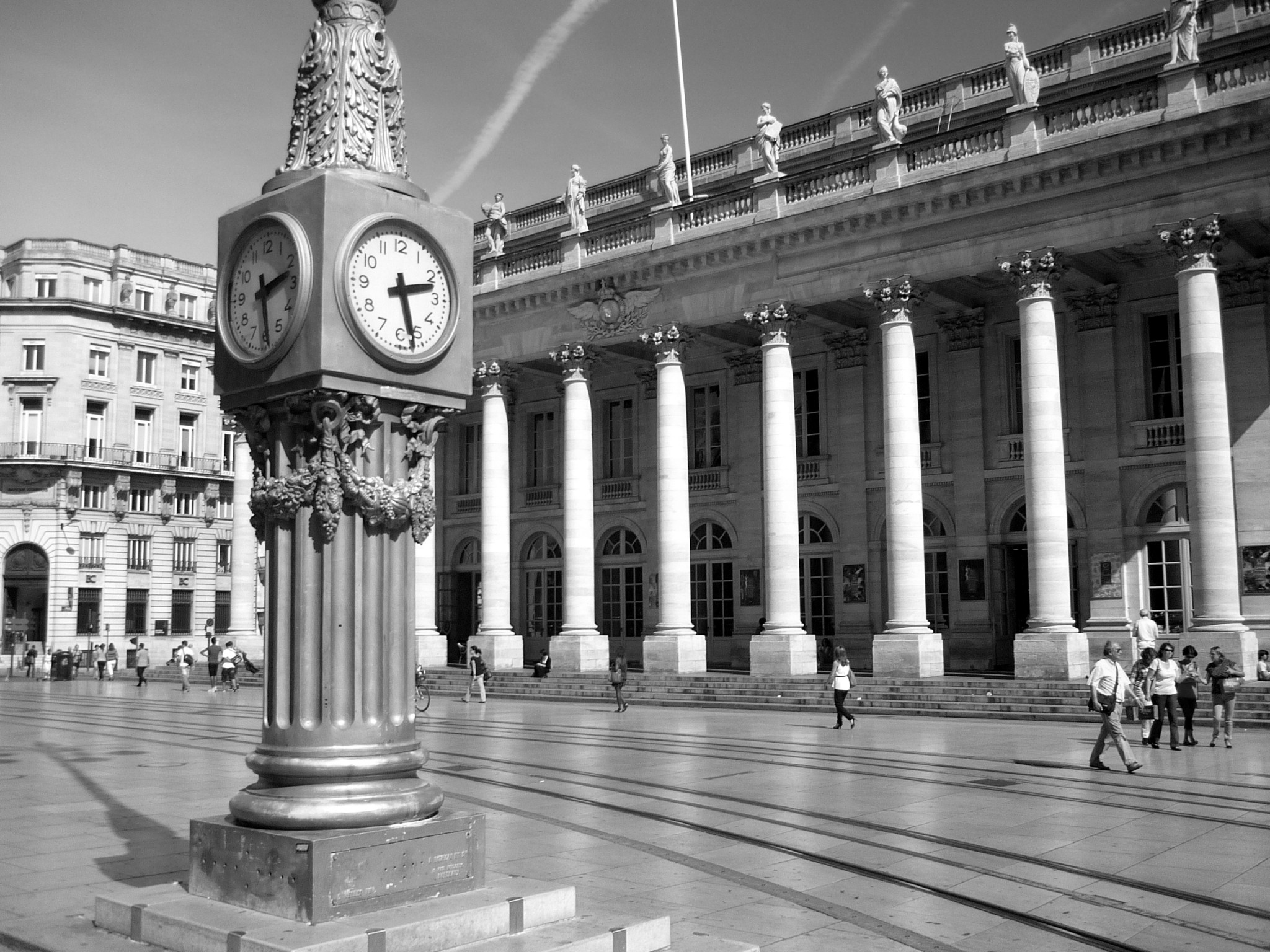
The “Grand Théâtre” was commissioned by the Governor of Guyenne, Louis Armand Duplessis, Duke of Richelieu. The construction of this 18th-century masterpiece of 88 meters on 47 meters was supervised by the architect Victor Louis. It was financed by the Freemasonry of Bordeaux which is why some people claim that it displays numerous symbols of Freemasonry.
The neoclassical style of the building is coherent with the opulent urbanism inherited from the Age of Enlightenment: the peristyle on its front makes the “Grand Théâtre” reminiscent of ancient times. It is composed of 12 statues aligned on the top of 12 Corinthian columns. They represent the 9 Muses and three goddesses from Ancient Greece: Euterpe (music), Urania (astronomy), Venus (the goddess of love), Calliope (epic poetry), Terpsichore (dance) Melpomene (tragedy), Thalia (comedy), Polyhymnia (sacred poetry), Juno (the goddess of fertility), Minerva (the goddess of war), Erato (lyric poetry) and Clio (History). These statues were designed by Pierre Berruer and carved by him and his assistant Van den Drix.
The outside stairs that lead to this peristyle, chosen as a rendezvous spot by many young people, did not exist before the Place de la Comédie, the square that lies at the foot of the Grand Théâtre, was lowered in 1848.
Behind the theatre’s doors, in the wide hall, 16 Doric columns support a coffered flat vault decorated with rosettes. Five archways lead the visitor to the stairs that will take him to the boxes. Divided into two lateral flights of considerable width, with low bannisters, the stairs are a stage where the aristocrats could perform their social role. Between the two flights of stairs, the main door is adorned with two caryatids carved by Berruer: Thalia and Melpomene.
On the day of its inauguration in 1780, when Racine’s Athalie was staged, it could receive up to 1,700 spectators. Many of the less well-to-do used to stand. But when seats were installed, the “Grand Théâtre” capacity shrank to 1,114. It is a “théâtre à l’italienne”, whose modest size allows the spectators to perceive the nuances of the performance. The exceptional acoustics of the theatre, due to the wooden frame that wraps the auditorium, also enhance the quality of the show.
The original colours of the theatre used to be gold, blue and white – the royal colours. But they were changed for old gold and red during the 19th century. With the 1990 and 1991 work that was organized to maintain the building and adapt it to the needs of the modern scenography, the original colours were restored in order to lighten the theatre.
The theme that can be observed today on the theatre’s dome was chosen and painted by Jean-Baptiste Robin: “Apollo and the Muses agree to the dedication of the temple built by the city of Bordeaux“. Many painters added their own work to the dome until Maurice Roganeau executed a faithful copy of the original painting in 1917.
In front of the theatre, on the other side of the Place de la Comédie, Victor Louis created in 1776 the façade of The Regent Grand Hotel, a luxury hotel. Its neoclassical style matches the Grand Théâtre’s architecture.
3. Le Cours de l’Intendance
The Cours de l’Intendance will take you from the Place de la Comédie to the Place Gambetta.
This was the site of a natural ditch that was already a pathway before the 3rd century. It was filled in and its name changed many times. It is now called the Cours de l’Intendance because the Intendant of Bordeaux built there his mansion with a garden, and a concert hall during the 18th century. All of this was destroyed during the Revolution.
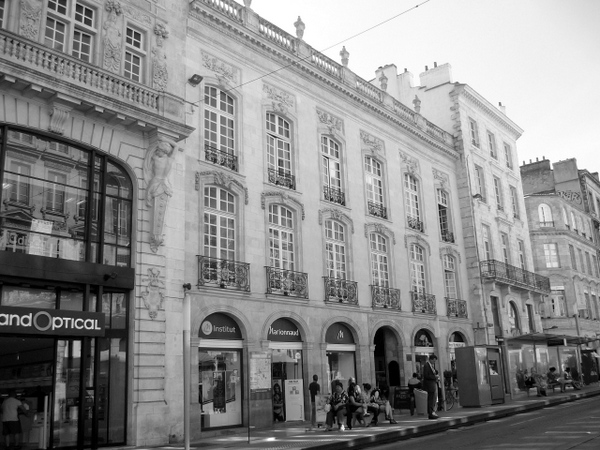
The Intendant was a high-ranking provincial representative of the French Crown. During the reign of Louis XV in the 18th century, the vision of Bordeaux’s Intendants was to transform the city into one of the most beautiful in France. To achieve this, and following grandiose urban planning. the city’s narrow medieval streets needed to be replaced by large avenues Once this plan was completed, the area quickly became the place where the rich and the bourgeois had their mansions built. Today there are mainly luxury shops like Lancel or Louis Vuitton. With Cours George Clemenceau and Allées de Tourny, Cours de l’Intendance composes the “Golden Triangle” (Triangle d’Or), home to some of the most prestigious shops in Bordeaux.
4. L’église Notre-Dame de Bordeaux
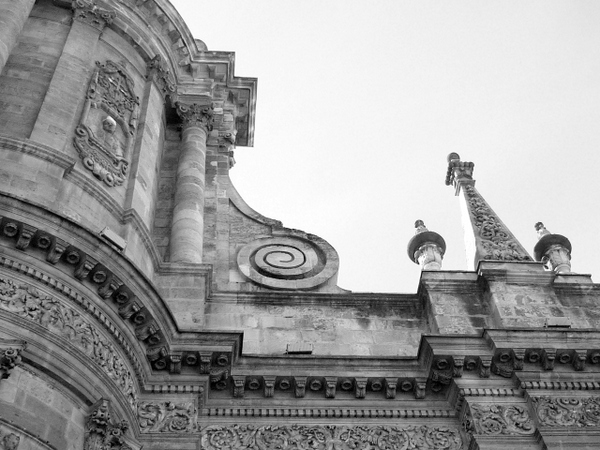
In 1678 the king destroyed the Dominicans’ monastery and church in order to enlarge the fortress of the “Château Trompette”. The Dominicans continued to thrive and built a new convent with two cloisters and one spacious church, Saint Dominique, which was finished in 1707 and which became Notre-Dame in 1802 after the Concordat.
The church was conceived in a baroque style by royal architect Pierre Duplessy-Michel and architect Mathieu Labat. It was inspired by the Gesù church in Rome.
Because of the proximity of another monastery, the doors of Notre-Dame church open to the east, which is the opposite of the usual orientation of churches.
The church’s front was carved in a baroque Jesuit style by Pierre Berquin and his sons. Above the door, the scene representing the Virgin giving the rosary to Saint Dominique gave its first name to the church. Under the medallions representing the faces of four Dominican popes, four statues from 1865 flank the doors and depict the great doctors of the Latin Church: Saint Ambrose, Saint Gregory, Saint Gerome and Saint Augustine.
The 60 meter long nave, whose barrel vault is adorned with beautiful stained glass windows and whose seven tall oval archways are topped by a prominent cornice, hosts many concerts thanks to its remarkable acoustics. Two wide balconies offer a view from above of the chancel and the marble altar with its two praying angels.
The wrought iron railings around the chancel, dedicated to the evangelists, were made by locksmith Jean Moreau. They include two bas-reliefs: the Lord’s Ascension and Mary’s Assumption. Behind the altar, the apse’s frescos (1834) display scenes of Mary’s life: the Presentation of Jesus at the Temple, the Death of Jesus, and the Visitation.
The two largest chapels, on each side of the nave, include a pair of beautiful altar pieces. On the left, Notre-Dame du Rosaire, also called the chapel of the Blessed Sacrament, has a statue of the Virgin and Child, but its interest mainly comes from two pictures painted by André Jean (“Frère Jean” or Brother Jean). One represents the Dominican Pope Saint Pius V praying during the battle of Lepanto, which concluded in the victory of Christianity against the Turks; and the other one represents Saint Rose of Lima, a young Dominican saint from Peru. You can find four other paintings by Brother Jean in the Church, all dated from 1712 to 1735.
But Notre-Dame’s masterpiece is its organ, commissioned to German Godefroy Schmidt by the Dominicans in 1785 to replace the old one. The organ buffet (the wooden frame of the pipes), decorated with musician angels and dominated by the great statues of King Saul’s musician, David, and the musicians patron saint, Saint Cécile, is Brother Durel’s work. This buffet was listed as a historical monument in 1971.
Because a part of the vault collapsed, the church was closed from 1971 to 1981 and entirely renovated, revealing the beautiful original stone. It was listed as a historical monument in 1981.
One of the two original cloisters, the Mably courtyard, is today the seat of the “Chambre Régionale de la Cour des Comptes”. It also hosts temporary exhibitions and cultural events.
5. Cathédrale Saint-André de Bordeaux
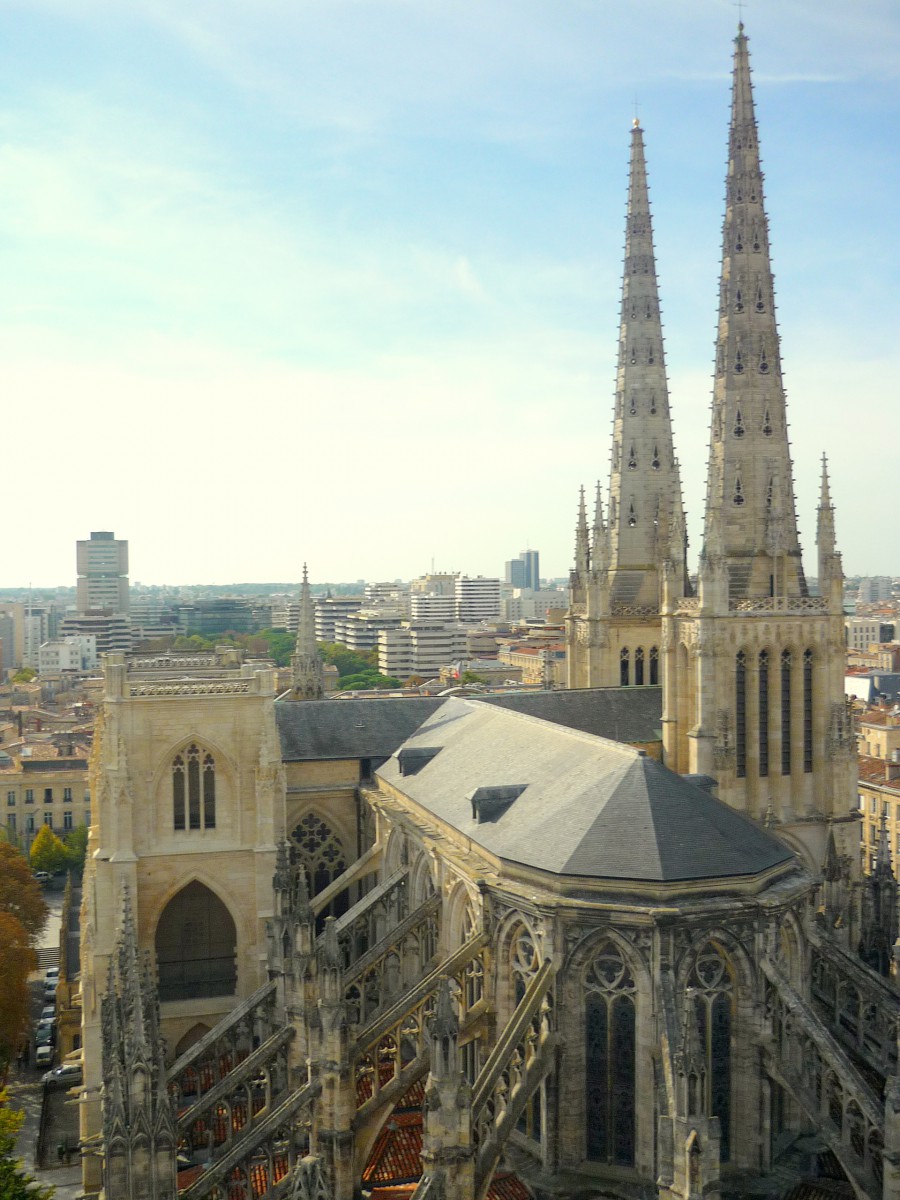
The Saint-André cathedral is an imposing Gothic edifice located in the heart of the city. It is the largest religious building in Bordeaux and was listed in 1998 by UNESCO as a World Heritage site.
The cathedral was built following the design of a Latin cross oriented on a west – east axis. Its single nave of seven bays is 124 metres long and 23 metres high, which is significantly lower than that of Metz Cathedral (41 metres), or Amiens (42.30 metres). The 23 metre-long transept with its two bays is higher than the nave, reaching 29 metres above the choir.
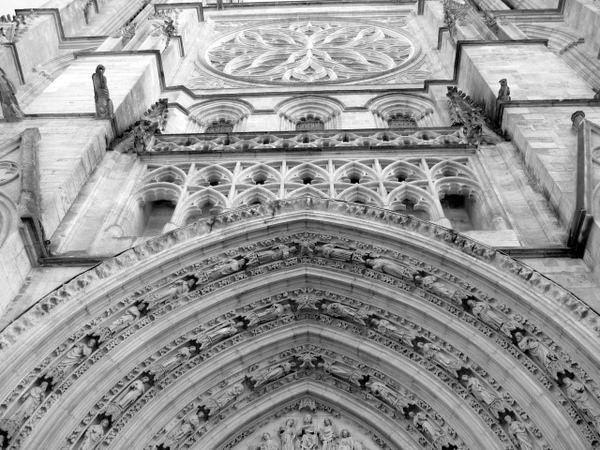
The Pey-Berland Tower was named after the archbishop of Bordeaux who founded the city’s first university c.1440. The bell-tower, built between 1440 and 1450, is isolated from the rest of the cathedral and is situated to the east of the chevet. It forms a rectangular edifice with buttresses, an exterior gallery, and is topped by a small octagonal spire which is surmounted by an 1862 statue of Our Lady of Aquitaine.
Find out more about Bordeaux Cathedral.
6. Rue Sainte-Catherine
Rue Sainte Catherine which stretches over 1,250 meters between the Place de la Comédie, south, and the Place de la Victoire, north, is Bordeaux’s main shopping street with more than 250 stores. It is one of the two axes that cross the city centre. Entirely pedestrian since 1984, it is often granted the title of “longest pedestrian street in Europe“. It was completely renovated by Jean-Michel Wilmotte between 2000 and 2003.
Rue Sainte Catherine was named after the Sainte Catherine chapel, inaugurated in 1048 by the Knights of Malta. Its last remains disappeared in 1835 when the Bazar Bordelais was built on its location. It used to be the only place where butchers and trip-sellers could sell their wares. Famous personalities used to live on Rue Sainte Catherine, like Montesquieu, who let his capable wife manage his castle, le Château de la Brède, and his land while he stayed in Bordeaux.
South, near the Grand Théâtre, you will find one of the entrances of the Galerie Bordelaise, a covered shopping gallery designed by the architect Durand and opened in 1834.
Walking down to the crossing with the Rue de la Merci and the Rue des Trois Conils, you will arrive on Place Saint-Projet. Its gothic stone cross used to be in the middle of a cemetery and was an object of veneration during certain religious celebrations. Dismantled during the Revolution, it was restored in 1803 thanks to the generosity of a lace seller from the Sainte Catherine neighbourhood. A fountain with four protecting patron saint statues was built there in 1715: Saint-Projet is holding the martyr palm, and the others are difficult to recognise, but it is possible to distinguish the Christ and the Virgin amongst them.
If you follow the Rue de la Merci to the east you will come to Place Camille Jullian, famous for its bars, restaurants and its independent movie theatre, the Utopia, located in what used to be Saint Siméon church. In the centre of the square lies a monument dedicated to Camille Jullian, a notorious historian from Marseille made up of Roman vestiges.
Keep walking northwards, and you will cross Cours d’Alsace-Lorraine. You will notice there a bas-relief reminder of the existence of underground watercourses that used to end in the Garonne: le Peugue and la Devèze.
We recommend that you enter French department stores such as Fnac and Galeries Lafayettes to enjoy French shopping.
7. Place de la Victoire
The Place de la Victoire is located at the southern extremity of Rue Sainte Catherine. Several large streets – Cours de la Marne, Cours de la Somme, Cours de l’Argonne, Cours Aristide Briand – begin here. Its main characteristics are the “Porte d’Aquitaine” (Aquitaine Gate), an obelisk and two bronze turtles.
The Aquitaine Gate was built in the 17th century, and was a symbolic and tax gate for the people who entered Bordeaux. The obelisk and turtles, made by the Czech Ivan Heimer, were unveiled in 2005. The obelisk consists of six blocks of red marble from Languedoc and bronze. The turtles are adorned with grapes and viticultural appellations. These three statues are arranged on a pavement inspired by the Capitol Square in Rome.
The big building on your right when you face the Aquitaine Gate used to be the Pharmacy University and is now the “Université des Sciences de l’Homme”. It is without a doubt the most beautiful university building of Bordeaux.
Place de la Victoire is surrounded by numerous bars and restaurants, and it hosts various events. It is frequented by university students who often gather here.
8. Église abbatiale Sainte-Croix
Sainte-Croix church was a parish administered by the abbey church of Sainte-Croix, which used to be the abbey of a Benedictine monastery. In this neighbourhood you would find a big mill near the church, the oxherds – Rue des Bouviers (Oxherds Street) – who took care of the oxen which pulled the boats on the river, potters – Rue des Fours (Ovens street) –, and sugar refineries when sugar began to be imported from the West Indies at the end of the 16th century.
The abbey was founded in the 7th century and destroyed twice by the Saracens during the 8th century. The present church was built between the end of the 11th century and the beginning of the 12th century, and became the parish see in 1130. Behind its Romanesque front, a 39 meter nave (15.30 m high) on a polygonal apse crosses a transept whose two arms both carry a smaller apse. The Benedictine monks used to sit in the chancel, while the parish’s faithful used to sit in the transept and on the sides. The main altar was dedicated to The Virgin.
The abbots let the ‘regular’ parts of the abbey slowly collapse, but the monks of the Saint Maur congregation constructed a new monastery between 1664 and 1672. In 1750 a monk, Dom Bedos of Celles, made the Sainte-Croix organ, considered a master-work today. The abbey became an alms house in 1793 and the “École des Beaux-Arts” (Fine Arts School) in 1890. Paul Abadie, who restored the abbey in the 19th century, symmetrically added a second bell tower to the building.
Today you can also admire three paintings from the beginning of the 17th century in the abbey: “Saint Mommolin healing a possessed man”, “Saint Maur healing a sick man” (G. Cureau) and “Feast of the Cross” (A. Bourgneuf).
9. Basilique et flèche Saint-Michel

The flat-bottomed barges carrying wood to Bordeaux used to stop at Saint-Michel to fuel the carpenters of the Rue Carpenteyre and the coopers of the Rue de la Fusterie (“fusterie” is the ancient French word for cooperage). The iron traders were located on Faures Street, while salt was stored at the Quai des Salinières (a dockside whose name is associated to its function) and meat dry fish on Rue Rousselle.
Today Saint-Michel is the liveliest neighbourhood in Bordeaux. There are Monday and Saturday markets and, under the spire of the Saint-Michel Basilica, the shops and stores are colourful and popular.
Saint-Michel church was listed as a historical monument in 1846 and became a basilica in 1903.
This neighbourhood and its church used to be outside the walls of Bordeaux. When these were included within the city, King Louis IX entrusted the architect Jean Lebas with the construction of a new church. In 1466, even though the church was not finished, a canon college settled inside its wall, turning it in an important stop on the Routes of Santiago de Compostela (Saint James’ Way). For this reason it has been part of the UNESCO world heritage since 1998. Corporations and brotherhoods financed the construction work, which was not completed before the 16th century.
The basilica is one of the largest religious places in Bordeaux: a 75 meter long and 23 meter high nave crosses a 38 meter long transept. It includes 17 chapels, each of them dedicated to a corporation or a brotherhood and many of them display artworks. One of them contains the grave of a “jacquet“, a pilgrim following the Routes of Santiago de Compostela.
The wide stained-glass windows which light the basilica are essentially from the 16th, 19th and 20th centuries. Among the oldest you will notice a red, yellow and blue Tree of Jesse. The chancel’s 19th century stained glasses were replaced by Max Ingrand after their destruction during bombing raids in the Second World War.
The Louis XV style organ buffet was built between 1762 and 1765 by Cessy and Audebert. The church was listed among the historical monuments in 1846. The great organs were made by Micot and were listed as historical monuments in 1987 only. They were recently restored.
Other points of interest:
- In the nave is an 18th century pulpit made of mahogany and marble topped by a statue of Saint Michel.
- Several numbered and carved tiles testify that the wealthiest used to be buried in the church. This practice was stopped in the 18th century for public health reasons.
The Saint Michel basilica shares a special feature with Bordeaux’s Cathedral Saint-Andrew: an independent steeple (or “campanile”), a few dozens of meters away.
The Saint-Michel spire was originally 99 meters high. It was weakened in the 1759 Bordeaux earthquake and was hit several times by lightning before the spire was taken down by a storm in 1768. The truncated steeple was a telegraphic relay at the beginning of the 19th century. From 1860 to 1869 Paul Abadie, the architect of the Sacré-Coeur in Paris (who also restored Sainte-Croix abbey), rebuilt the spire and restored the church in a Flamboyant Gothic style. The steeple is now the highest of Southern France at 114.60 meter and contains 22 bells.
A 2.50 euro fee allows you to climb up the spire to enjoy one of the most beautiful views in Bordeaux.
Particular to the Saint-Michel bell tower is its basement that contained a crypt which had been an ossuary and an exhibition place from 1791 to 1979. When the parish cemetery was turned into the Meynard Square, the bones and Saint-Michel mummies, found during this work, were reburied again in the Chartreuse cemetery.
10. Grosse Cloche

Along with Porte Cailhau, the Grosse Cloche (“Big Bell“) is one of Bordeaux’s rarest medieval monuments. Originally it was composed of six towers and one storey. Successive modifications changed its shape between the 15th and the 17th centuries and today it is composed of two circular 40 meter high towers linked by a central building. After a fire in 1755, a small tower with a lantern (“campanile”) was added to the top of the building.
For a long time the “Big Bell” was time Bordeaux’s belfry. On its bronze corolla one can read:
“J’appelle aux armes, j’annonce les jours, j’indique les heures, je chasse les nuages, je célèbre les fêtes, je pleure les morts”
(I call to arms, I announce the days, I indicate the hours, I chase away the clouds, I celebrate the festivities, I mourn the dead).
Bordeaux’s magistrates also used to ring the Big Bell to announce harvest time or to warn people of fire. The people of Bordeaux used to love this bell, the symbol of their city. When the king wanted to punish them, he would take it off or break it, as Henri II did in 1548 after a revolt. A new one was forged in 1561. The present bell, forged by Turmel in 1755, weighs 7,800kg.
On the parapet one can see the city’s arms:
- the English leopard recalls that the Guyenne, Bordeaux’s area, was under English rule from 1188 to 1453.
- the castle represents the city’s wall and the belfry of the old city hall.
- the crescent represents the Garonne’s (Bordeaux’s river) curve.
- the lily flower affirm the royal family’s power.
Above the clock, made by Paul Laroque in 1759 to replace the old one, there is a graduated sundial. Owing to seasonal variation in the time of sunrise, one is permitted to subtract or add a few minutes to the time displayed on the clock.
11. Pont de pierre
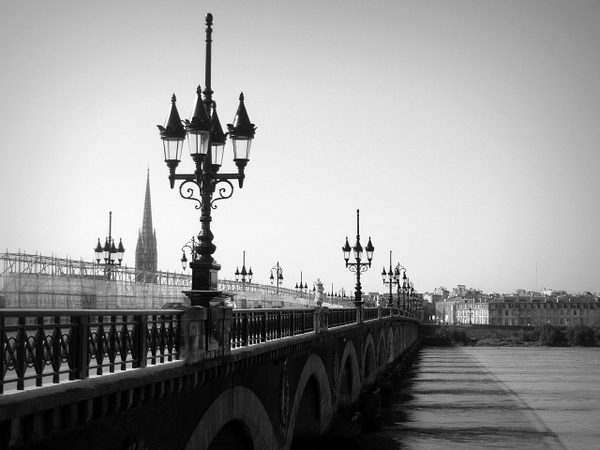
Pont de pierre was the first bridge built over the River Garonne at Bordeaux. The translation of its name is “stone bridge“. Its construction was commissioned by Napoleon Bonaparte in 1810. It is supported by 17 arches as the emperor’s name comprised 17 letters. The white medallions on the brick pillars are a tribute to Napoleon. The bridge also displays the city’s coat of arm: three interwoven crescents representing the curve of the Garonne.
Because of the strength of the current, the engineers Deschamps and Billaudel had to use an English diving bell to stabilise the bridge’s pillars underwater. The bridge was finished in 1822. Until 1965 it was the only bridge over the Garonne that permitted cars and from 2003 it has supported the new tramway. It was listed as a historical monument in 2002.
12. Porte Cailhau

The Porte Cailhau used to be part of the city wall. It was opened in the city’s wall at the bottom of the Place du Palais (Palace Square) in 1496. It was a defensive gate and a late Gothic style triumphal arch, built to commemorate the victory of Charles XIII in Fornovo, Italy, in 1495. Above its entrance a niche contains a statue of the king. There are two theories concerning the origins of its name:
- The name of a wealthy bourgeois family which gave Bordeaux several mayors: Cailhau.
- The stones that the Garonne that were used as ballast for ships. A stone is “cailloux” in French, and “calhau” in Gascon, an ancient and almost forgotten local dialect.
The gate was restored in the 19th century and its damaged bas-reliefs are kept in the Aquitaine Museum.
In the 10th century, the Place du Palais bordered the Palais de l’Ombrière (Ombrière Palace), where the Dukes of Guyenne used to live. Louis XII stayed in this palace while he was in Bordeaux to marry Eleanor of Aquitaine. It was replaced by another palace in the 13th century and by the Parliament of Bordeaux in 1462. Damaged by fires in 1597 and 1704, it was destroyed in 1800, permitting the opening of the present Rue Palais de l’Ombrière.
13. Quartier Saint-Pierre
The neighbourhood was named after its church, which was listed as a historical monument in 1908. Since Bordeaux is located on the banks of the Garonne, one on the five main French rivers, its harbour played a key role in its development. Saint Peter was the patron saint of the fishers and the seamen, and Saint Pierre church was built on the location of the former Gallo-Roman harbour. Legend has it that, before Saint Pierre, Hercules used to watch over the harbour. His statue, a tall Hellenistic bronze that is now one the most beautiful pieces of the Aquitaine Museum, was found in 1832 under Saint Pierre square.

In the 12th century the quays were moved to the south, the original harbour was filled and the Saint Pierre neighbourhood was built instead. In the 18th century, intendants Boucher and Tourny cleared the neighbourhood destroying the medieval wall and creating Place de la Bourse, Rue Royale (today Rue Fernand Philipart) and Place du Marché Royal (today Place du Parlement). This explains why neo-classical mansions were built in this neighbourhood with mouldings, stone mascarons and worked iron balconies. Mascarons are masks of stone found in many façades of Bordeaux’s mansions. We advise you to have tea in “Ailleurs à Bordeaux” (“Somewhere Else in Bordeaux“), a very pleasant tea house.
14. Place de la Bourse
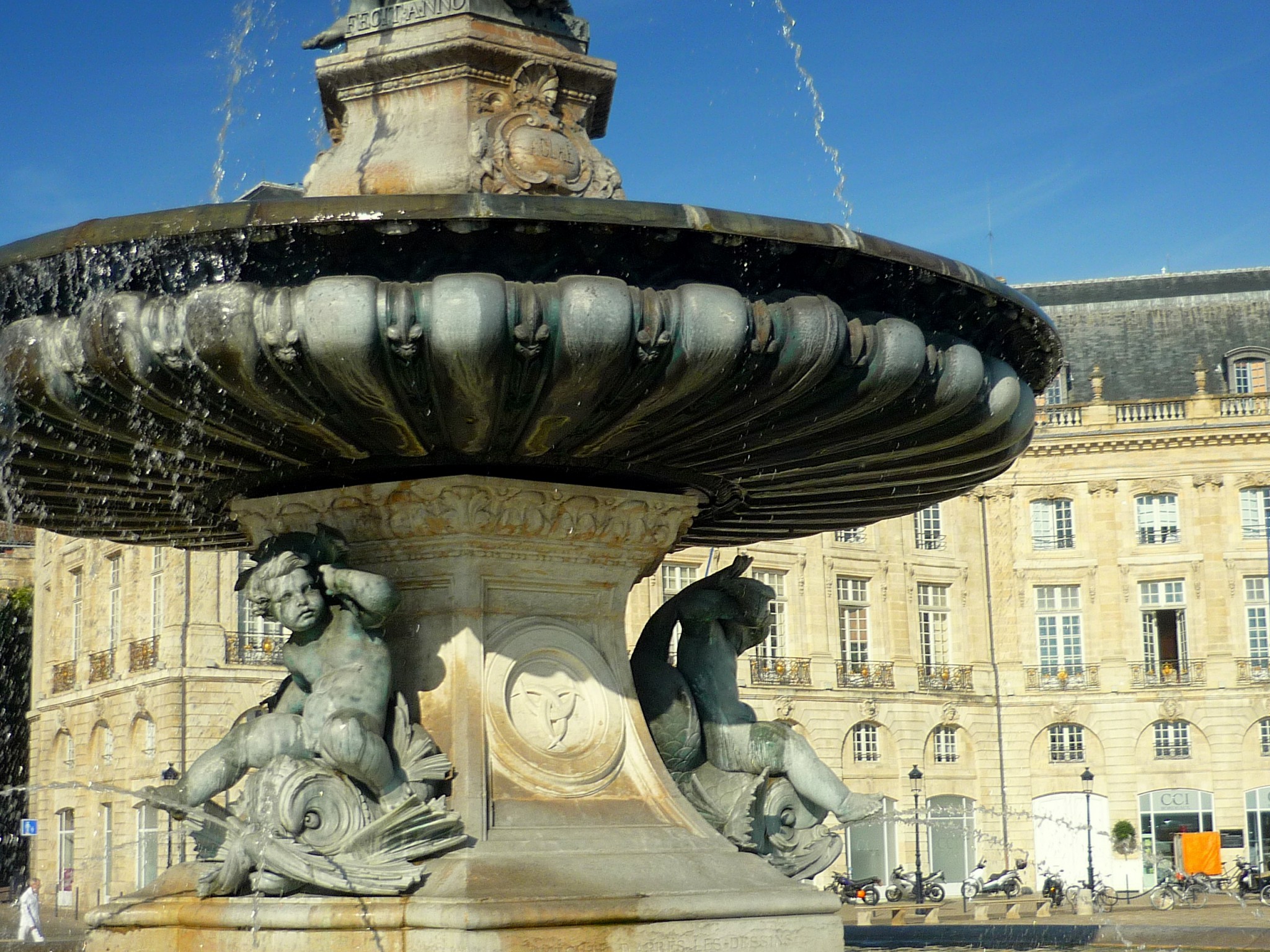
King Louis XV wanted a royal square to be laid out in Bordeaux. He commissioned it from intendant Boucher and entrusted the royal architect Ange-Jacques Gabriel with its construction. The Stock Exchange Hall to the north, the Farms Hall to the south, a central building to the West and the Garonne River to the South, framed its rectangular shape. It showed Boucher’s will to open Bordeaux onto the river, to display a welcoming and prestigious image to the travellers from other cities and countries. A part of the city wall was dismantled in order to create a square that is meant to be a symbol of Bordeaux’s prosperity.
Find out more about Bordeaux’s Place de la Bourse.
You can continue your discovery of Bordeaux by exploring the Chartrons district, north of Place des Quinconces. With its fine façades, this area is the historic hub of Bordeaux’s wine trade and makes for a nice stroll along the quays of River Garonne.
Tourist information office: http://www.bordeaux-tourisme.com



Your North and South on the Saint-Catherine are backwards!!!
The place de la Victoire is on the South end and the Place de la Comedie is on the North side.
Hi, thank you for spotting this typo, I’ve just corrected it.